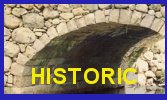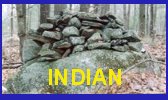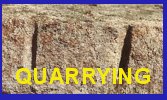|
Interpretation
Split-stone without stone fill that has other features associated with it is always a spirit portal to the Underworld (see examples). Portal is an exit and entrance. Split stone is not the only type of portal used to access the Underworld see Gungywamp article on web page and America’s Stonehenge Deciphered book. The earliest known use is at America’s Stonehenge site with the winter sunset ceremony. In this ceremony Sun Spirit enters the Underworld on the winter solstice. In the same ceremony Underworld Spirit accompanied Sun Spirit and used the same spirit portal. Sunset ceremony was established circa 2500 B.P. The first known C14 date is 1900 B.P. associated with the creation of the spring equinox ceremony. The latest date is circa 1850-90 A.D. at the St. Martin site in E. Kingston, NH where a boulder was deliberately split by the plug and feather method for use in a ceremony.
Split-stone with stone fill is classified as a cairn. The cairn is connected to the Underworld. The cairn has several variations of design but what is common to all is the split(s) is filled with stones. The base stone can be a boulder with one or more full splits, a boulder with one or more cracks, an outcrop – bedrock that protrudes above ground in a boulder like way, and raised bedrock with an exposed ledge face. In one case, two boulders were used with fill in between that appear to be equal to a split boulder. Splits in bedrock are sometimes called fissures.
Examples of Usage
Example #1 – E. Kingston, NH
St. Martin site in E. Kingston is a cairn site built on the backside of a farm. The farm was on property that starts out on level ground at the road and then goes up a steep hill. It was on top of hill that the site was built circa mid to late 1800. The site has several areas, of interest is the enclosed field with a split boulder. The boulder was split by the plug and feather method and left in tact with a narrow open-space in the middle. Directly south of boulder a few feet away a cairn is attached to a stone wall. On the west end of enclosed field is another split boulder that is natural. It has a narrow split that has stone fill and stone piled up against its base around part of the boulder. This is a split boulder cairn with stone leaning against it. The other areas at this site contain cairns, a spring, and enclosures. They are separated by stone walls.
The intact split boulder is a man-made spirit portal to the Underworld. It is an exit portal for Underworld Spirit. The cairn across from the split boulder without fill was used to place a stone offering to call forth Underworld Spirit. The cairn being attached to the stone wall brought the spirit over to the wall where it could travel. The Underworld Spirit traveled along the wall to the area near the split boulder cairn. A leader placed a stone offering at base of split boulder cairn to call the spirit over to the feature. The stone filled split allowed the spirit to enter the boulder but prevented it from entering the Underworld. The split boulder cairn became a containment feature where Underworld Spirit stayed during the ceremony.
|







